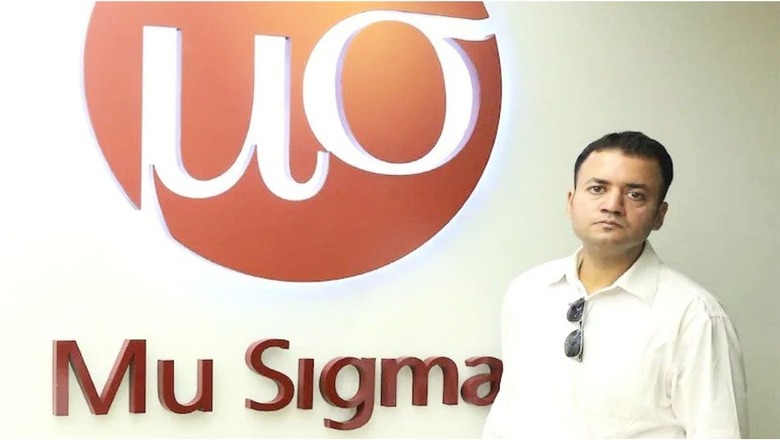
views
Data analytics firm Mu Sigma’s founder Dhiraj Rajaram has bought back shares held by the company’s investors Sequoia Capital and General Atlantic, gaining full ownership of a firm that he founded nearly two decades ago, at least three people familiar with the development said.
“General Atlantic and Sequoia together put $200-$300 million in Mu Sigma and they would make at least 2.5-3 times on the investment. They have been investors in the company for many years and were looking at an exit,” one of the persons cited above said. Private equity and venture capital funds usually have an investment horizon of 8-12 years in a firm. Mu Sigma was last valued at $1.5 billion in 2013.
A second source said Rajaram has no plans to raise capital from new investors. “He doesn’t need to as the firm has been profitable. They might do an IPO in the US in the near future if they need the money.”
Rajaram did not respond to messages or calls. Moneycontrol has mailed Sequoia and General Atlantic and will update this story when we receive a response.
Both funds invested in Mu Sigma in 2011 and were among its largest shareholders, together holding nearly 38%. Rajaram became the largest shareholder in 2017 with a 52% stake after his former wife and shareholder Ambiga Subramanian exited the firm.
With the current transaction, he will now control 85% of the firm, with the rest held by employees and a few angels. A significant portion of the remaining equity will be allocated to current and future employees, apart from members of the management team who will invest and become shareholders, sources said.
The firm has 14 angel investors, who have together netted a return of over $100 million on an initial investment of $125,000. Some of them include Ashish Gupta of Helion, Prashanth Prakash and Subrata Mitra of Accel, and American businessman Bill Campbell.
The buyback will be funded by a mix of cash and debt. The last time around, Rajaram got a $400 million credit line against his shares from Barclays, Deutsche Bank, Standard Chartered, and Credit Suisse to buy out Ambiga’s stake, apart from a portion of the company’s cash. This credit has been repaid in full, sources said.
A new chapter
The transaction marks a new chapter for Mu Sigma after many years of struggle. While it was one of India’s early unicorns and among the hottest startups during the 2014-15 period, it went through a difficult phase post the exit of Ambiga Subramanian.
“Because of the distractions at the founder level, its annual revenues dropped from $180 million to $110 million. But now it is again clocking an annual revenue run rate of $150-175 million, with an EBITDA of $65-$70 million,” a third source said. EBITDA, or earnings before interest, taxes, depreciation, and amortisation, is a measure of a company’s performance. Very few startups in India are EBITDA positive. Industry executives said what sets Mu Sigma apart is its service as a software model, which helps the company command better margins.
Mu Sigma also spawned a generation of specialists and founders in the data analytics space, who went on to lead data functions at leading consumer internet startups in India and multinational firms, apart from starting up their own firms. The company has trained over 14,000 employees at its Mu Sigma University, which coaches them to become decision scientists in data-driven behavioral analytics, financial analytics, big data analytics, business decisions, and more.
Market for data analytics
Mu Sigma was founded by Dhiraj Rajaram in 2004 and helps enterprises with data-driven decision-making. The firm works with Fortune 500 companies and employs close to 3,500 people. Headquartered in the US, the company has raised total funding of 300 million from a clutch of investors including FTV, General Atlantic, Sequoia, Fidelity, and MasterCard. The company crossed the $1 billion valuations in 2013.
It derives 33 percent of its revenue from the healthcare and life sciences sector, 20 percent from financial services, 15 percent from technology media and telecom, and 30 percent from the retail and CPG segment. Its top clients include Microsoft, Walmart, AbbVie, and Citibank, among others.
It competes with firms such as Fractal Analytics and LatentView Analytics. Fractal Analytics was recently valued at $1 billion after investment from TPG Capital Asia. LatentView saw a blockbuster listing in 2021 when its issue was oversubscribed 338 times. The company’s market cap now stands at $1.4 billion.
This comes on the back of the huge demand the data analytics market is witnessing. When the pandemic struck in 2020, demand for technology saw an unprecedented increase. As people consume more services online, enterprises across the world need to make sense of the huge volumes of data that are being generated.
Data analytics firms help enterprises make sense of this data that can be used to gain more insights into user behaviour, optimise operations, and better decision-making.
Read all the Latest Business News here




















Comments
0 comment